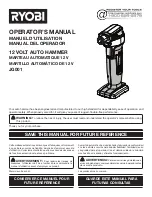
7
7
7.
Dressing material edges.
Always chamfer and deburr all sharp edges.
8.
Do not force tool.
Your machine will do a better and safer job if used as intended.
DO NOT
use inappropriate attachments in an attempt to exceed the machines rated capacity.
9.
Use the right tool for the job.
DO NOT
attempt to force a small tool or attachment to do the
work of a large industrial tool.
DO NOT
use a tool for a purpose for which it was not
intended.
10.
Dress appropriate.
DO NOT
wear loose fitting clothing or jewelry as they can be caught in
moving machine parts. Protective clothing and steel toe shoes are recommended when
using machinery. Wear a restrictive hair covering to contain long hair.
11.
Use eye and ear protection
. Always wear ISO approved impact safety goggles. Wear a full-
face shield if you are producing metal filings.
12.
Do not overreach
. Maintain proper footing and balance at all times.
DO NOT
reach over or
across a running machine.
13.
Stay alert
. Watch what you are doing and use common sense.
DO NOT
operate any tool or
machine when you are tired.
14.
Check for damaged parts
. Before using any tool or machine, carefully check any part that
appears damaged. Check for alignment and binding of moving parts that may affect proper
machine operation.
15.
Observe work area conditions
.
DO NOT
use machines or power tools in damp or wet
locations. Do not expose to rain. Keep work area well lighted.
DO NOT
use electrically
powered tools in the presence of flammable gases or liquids.
16.
Keep children away
. Children must never be allowed in the work area.
DO NOT
let them
handle machines, tools, or extension cords.
17.
Store idle equipment
. When not in use, tools must be stored in a dry location to inhibit rust.
Always lock up tools and keep them out of reach of children.
18.
DO NOT operate machine if under the influence of alcohol or drugs
. Read warning
labels on prescriptions. If there is any doubt,
DO NOT
operate the machine.
19.
DO NOT
bypass or defeat any safety interlock systems.
20. Keep visitors a safe distance from the work area.
CAUTION:
Never connect to an air source capable of exceeding 120 PSI.
Over pressurizing the tool may cause bursting, breakage, or serious personal injury.
Summary of Contents for HSP-30A
Page 10: ...8 8 MACHINE SAFETY LABELS...
Page 17: ...15 15 GETTING TO KNOW YOUR MACHINE 7 13 11 9 12 31 Hardware 5 10 6...
Page 28: ...26 26 PARTS DIAGRAM FRAME...
Page 30: ...28 28 Item Description Qty 34 Pump Assembly 1 35 Release Valve 1 36 Plug 1 37 Oil Hose 2...
Page 31: ...29 29 PARTS DIAGRAM HYDRAULIC ASSEMBLY...
Page 34: ...32 32 PARTS IDENTIFICATION MAIN CYLINDER...
Page 36: ...34 34 HYDRAULIC SCHEMATIC Handle Air P...
Page 38: ...36 36 NOTES...
Page 39: ...37 37 NOTES...










































